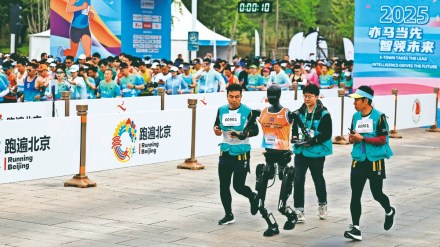This year in April, China made headlines by hosting the world’s first humanoid half marathon in Beijing. In this race, 21 humanoid robots competed on a 21-kilometre track alongside thousands of human runners. These robots were between 1.5 and 6.5 feet tall and had a humanoid structure capable of bipedal walking or running. This half-marathon saw 12,000 human participants alongside robots developed by more than 20 companies. Some robots fell. Some overheated. But six of them finished the race, an extraordinary achievement in the world of robotics. The winner, a robot named Tiangong Ultra, completed the marathon in just over two and a half hours. It had to change its batteries three times and stumbled once, but still crossed the finish line. The event wasn’t just about fun. It was a serious test of robotic endurance, balance, and real-world performance.
There’s a fascinating new trend emerging in the world of technology: the rise of humanoid sports. This futuristic form of athletic competition features robots that look and move like humans, competing in races, games, and physical challenges. Once fantasy, humanoid sports is now real, capturing global attention.
Last week, humanoid robots kicked, scored and tumbled while competing at a ROBO League football tournament in Beijing, China. Four teams faced off in a series of 3-on-3 games, with the robots operating autonomously using AI driven strategies. The event was a preview to the upcoming World Humanoid Robot Games to be held in August.
The preview match was organised by China’s Booster Robotics and state-owned Shangyicheng (Beijing) Technology and Culture Group, which focuses on XR technology and immersive experiences. A key aspect of the match was that all the participating robots operated fully autonomously using AI-driven strategies without any human intervention or supervision. Equipped with advanced visual sensors, the robots were able to identify the ball and navigate the field with agility. They were designed to stand up on their own after falling. However, during the match several still had to be carried off the field on stretchers by staff, adding to the realism of the experience.
Cheng Hao, founder & CEO of Booster Robotics, the company that supplied the robot players, told the media that sports competitions offer the ideal testing ground for humanoid robots, helping to accelerate the development of both algorithms and integrated hardware-software systems.
With robot marathons, China has already announced plans to launch the World Humanoid Robot Games next month, a global sporting event for robots. The games will include sprinting, soccer matches, gymnastics challenges, robots performing real-world tasks, like carrying packages or climbing stairs and more. More than 30 robotics teams from countries, including the US, Brazil, Germany, the Netherlands, Italy, Portugal, Japan, Singapore, Australia, the United Arab Emirates and Indonesia have signed up for pre-registration.
This year’s games will feature events including martial arts, impulsive movement and warehouse sorting skills competitions. While these games are meant to promote innovation in robotics and possibly position China as a leader in AI and engineering, the humanoid sports involve robots with human-like bodies taking part in athletic activities. They walk, run, balance, and even fall, just like people. They’re designed with legs, arms, sensors, and advanced software that allows them to move and react in real time. There are other countries investing in humanoid sports. Japan, for instance, has long been a pioneer in humanoid robots, with events showcasing robots dancing, fighting, and playing games.
The Tokyo 2020 Olympics featured Japanese robotics, with robots playing various roles like welcoming visitors, assisting with logistics, and even retrieving equipment. These robots were designed to enhance the visitor experience and streamline operations, showcasing Japan’s technological prowess. In fact, last year, researchers at Nara Institute of Science and Technology in Japan developed a new robot that can play video games with a human user. The US has gone a step ahead to host challenges like the DARPA Robotics Challenge, testing how robots can navigate tough environments. It was a competition focused on developing robots for disaster response. The challenge ran from 2012 to 2015 and was aimed to advance the capabilities of
semi-autonomous robots for complex tasks in dangerous, human-engineered environments.
So are humanoid sports important?
At first glance, humanoid sports may look like high-tech entertainment. But they serve a much bigger purpose like innovation testing. While sports are unpredictable, they push robots to make quick decisions, balance themselves, and adapt to changes at the same time, improving on technology. All the lessons from these games help engineers build better robots for homes, hospitals, factories, and even disaster zones.
However, as technology improves, we can expect exciting developments like robot leagues that tour the world, just like professional sports; virtual reality experiences where viewers can step into the robots’ perspective.
